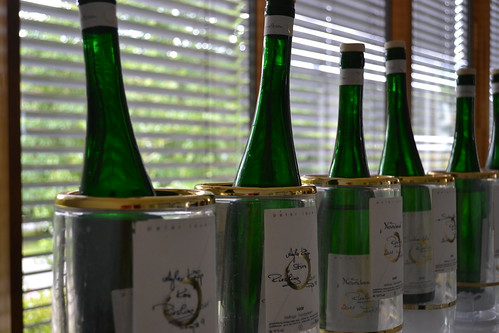26
German Riesling Adventure: Northern Saar – Hofgut Falkenstein
Posted by | Posted in Grape Adventures, Wine Reviews | Posted on 12-26-2012

"Winzer Weber"
This entry is part of my German Riesling Adventure, a weeklong trip to wine country last August. To read the rest of the posts, including the introduction, click here.
After our visit to Geltz-Zilliken, where we also tasted the wines of Peter Lauer as part of the SaarRieslingSommer festival, we drove to the northern Saar for an appointment at Hofgut Falkenstein.
Hofgut Falkenstein is a relatively young (for Germany) winery, having existed around 30 years, yet everything about the place is traditional and makes it seem like it’s been around forever. The vines are old (over 70% are 30+ years old, the oldest are between 60 and 80). The grapes are harvested by hand and crushed in whole clusters with an old spindle press. The wines are fermented with natural yeast and aged in ancient 1000-liter oak casks before being bottled and labeled by hand. Like I said, old school.
Erich Weber, the winemaker and proprietor, is himself something of a throwback. He calls himself “Winzer Weber,” which means wine grower, as he prefers to let the land and the grapes do most of the work. Lars Carlberg describes Erich as “one of the most genuine and modest growers in the region.” Hofgut Falkenstein is a labor of love, not a financial investment. As Erich told me during our visit, “Too much money is something not so good.”
We tasted through the lineup of 2011 wines with Erich and his son, Johannes, one of three brothers, but the one most likely to take over from his father some day. The curly-haired Johannes attends Geisenheim, the famous winemaking school I mentioned in my introduction, and is every bit as passionate about the land and the wine as his dad. If I had to guess, we were meeting with another future “Winzer Weber.”
Hofgut Falkenstein grows a bit of Pinot Blanc and Pinot Noir, but as this was a Riesling adventure, that’s what we stuck with. The wines overall are of tremendous quality. Pure and precise, subtly sweet, and refreshing. I had no history with the estate before this visit, so I cannot compare the 2011 lineup to prior vintages, but I can say that we enjoyed every wine we tasted. I should add here that this tasting was conducted in perhaps the most serene setting of our entire trip. We gathered with the Webers around a picnic table, surrounded by brick-walled gardens, overlooking steep, slate vineyards beckoning down towards the village below. It was a relaxed tasting, punctuated by wide grins and hearty laughs; the epitome of how good wine and good people can elevate an experience into something magical. Join me below for my impressions of the wines… Read the rest of this entry »

 This entry is part of my German Riesling Adventure, a week long trip to wine country last August. To read the introduction,
This entry is part of my German Riesling Adventure, a week long trip to wine country last August. To read the introduction, 




